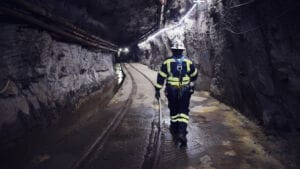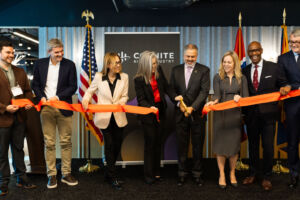“You can’t just say you ‘support regionalism,’ you have to believe it.” Surprise Mayor Sharon Wolcott is talking about attitude in the West Valley.
Thirty minutes earlier in a separate conversation, Goodyear Mayor Georgia Lord made nearly the same comment. “We believe in regionalism and we put it into practice,” she says. “On this side of the Valley, it’s not just words, it’s real.”
District 5 Maricopa County Supervisor, Clint Hickman, points out the window of his 10th floor office. “They place us so when supervisors look out the window, we’re looking at our district,” he said. Gazing across West Phoenix, the dome of University of Phoenix stadium is clearly visible in front of the White Tank Mountains. “I was born and raised in the West Valley,” he continues. “As a business owner, a public servant, and West Valley native, I believe we’re stronger for working together.”
Talk to any business leader about the West Valley, and the words heard are “regionalism,” “working together” and “diversity.” Maricopa County districts 4 and 5, and 15 communities from Surprise to Gila Bend, Wickenburg to Phoenix are starting to flex economic development muscle. When the synergies are totaled, the sum is the United Cities of West Valley.
The spirit of cooperation west of Interstate 17 is a break from history. As recently as a decade ago, West Valley cities were clawing for territory, car dealers, and the next power center. Tens of thousands of families were driving to qualify for affordable homes popping up in dozens of sprawling tracts. Politically, there may as well have been walls running down city limit lines.
Then came the recession. The economic downturn had a chilling impact on the West Valley. Faced with abandoned neighborhoods, empty strip centers and vacant warehouses, municipal revenue streams dribbled to nothingness. What was the norm wasn’t working.
The change started quietly. “It all began shifting over the past three to four years,” recounts Lana Mook, mayor in El Mirage. “We, the area’s mayors and business leaders, realized we would be a lot stronger working together than working separately.”
The challenge was bringing together the region’s assets and promoting the area. The catalyst had been sitting there since 1990. The Western Maricopa Coalition (WESTMARC) was the one place where mayors, businesses and public officials connected. In 2011, the WESTMARC board appointed a former Greater Phoenix Economic Council (GPEC) senior vice president to the role of president and chief operating officer. Michelle Rider took the reins of an old organization with a new charge.
The regional development organization took on a new focus. Its board of directors and Rider decided to leave business recruitment to organizations like GPEC, Arizona Commerce Authority and individual cities’ economic development departments.
“We saw our role as creating a strong environment in which business can flourish,” she explains. “We focus on three priorities. Our efforts are to promote the West Valley, enhance economic development and increase member value. We partner with GPEC and Arizona Commerce; they have the recruitment resources. We need to ensure when a business comes knocking on our door, we’re ready.”
“Let’s say there are a lot of misunderstandings about the West Valley outside the West Valley,” muses Mayor Lord. “Many of those misunderstandings are because people’s only experience with the Valley is sitting in traffic on I-10 when returning from California. They haven’t stopped here to explore.”
“I drive to work in the morning between two of the most beautiful mountain ranges in the state,” Supervisor Hickman says. “I look at the vast expanses of open land, the many homes, the business clusters we have, and realize, there’s a lot to offer.”
Site selection consultants look at many factors before plopping a business into a market. Key among those are similar firms, transportation and workforce. The West Valley has a well-kept secret. It is home to significant diversity in the three key siting factors. The region is home to a diverse collection of business sectors.
Mayor Wolcott lists the base: “Manufacturing and logistics, healthcare, advanced business services, aerospace and renewable energy businesses are located all over the region. We have the most diverse business and population base in the state.”
There’s another asset: Maricopa County west of I-17 has vast tracts of undeveloped, single ownership land.
“We learned from the rapid development in the East Valley,” explains Mayor Lord. “The cities in the West Valley have jealously guarded industrial land, Luke Air Force Base and our transportation corridors.”
One of the region’s major corridors has a significant cheerleader. Mayor Wolcott has pressed for improvements to Grand Avenue since she first took office. “This is a multimodal corridor that’s unique to the West Valley,” she says. “No other road in the state is like this. It connects ten cities and runs from the Capitol to Wickenburg; essentially, it runs all the way to Las Vegas.”
“The West Valley has an extraordinary mix of transportation modes,” echoes Mayor Mook. “We have both (Union Pacific) and (Burlington Northern) rail roads, a collection of spurs, (Loop) 303, I-10 and some day, I-11.”
The biggest asset in the region is its workforce. “Goodyear is the sixth fastest growing city in the United States,” Mayor Lord says with pride.
The rest of the West Valley is growing rapidly. In 2010, the region was home to 39 percent of the County’s population, according to the Maricopa Association of Governments. By 2040, MAG says the share will climb to 46 percent for the region.
“Every work day you can almost feel the land tilt,” says Mayor Wolcott. “The roads are filled with our residents driving out of our region to go to work. We have a significant, well-educated workforce who’d rather work closer to home.”
More than half the Northwest Valley’s workforce commutes into Deer Valley, Central Phoenix and the Scottsdale Airpark.
“We want our residents to stay closer to home, and we’re working as a region to make that happen,” Mayor Lord is emphatic about cutting the commutes.
Manufacturing, medicine, aerospace, renewable energy and advanced business services. These are the roots of the “West muscle” promoted by WESTMARC.
Rider is passionate about all of this. “We’re bringing our members together as a powerful force to make these assets known. There’s a story to tell, and we’re getting the word out.”



